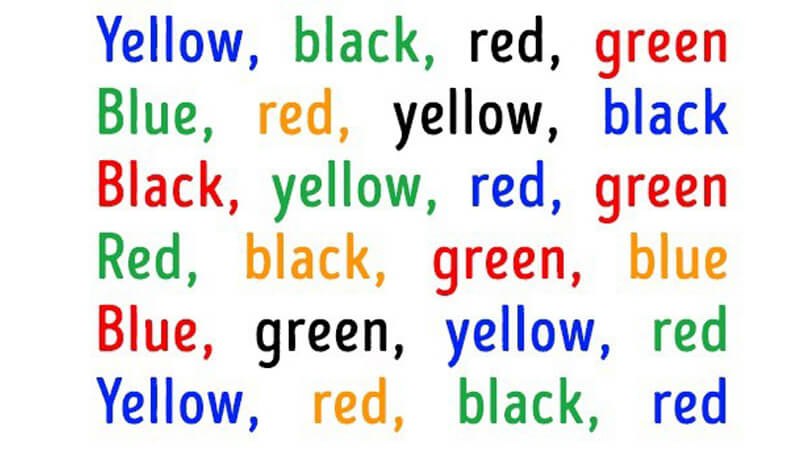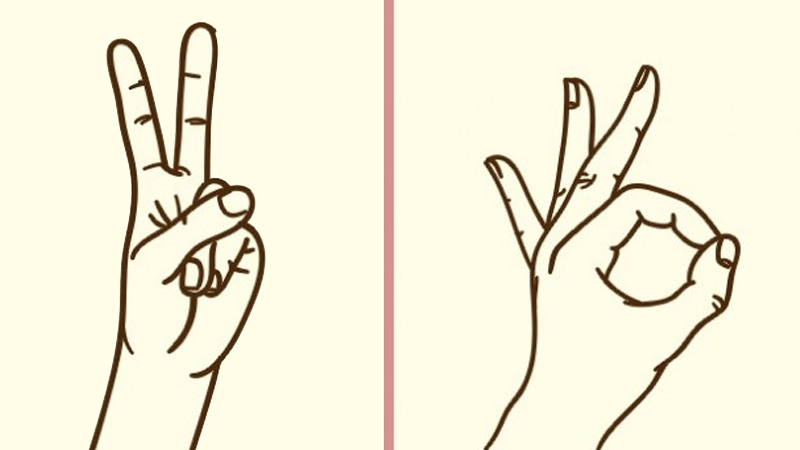Numbers, characters, words, colors, and images—these are all tools to get your brain moving. By engaging in activities that require active thinking, perception, analysis, processing, memory, and association, you’re giving your brain a workout. But it’s not about making your brain tired and stressed; it’s about making it fun and engaging, like a challenging puzzle.
1 Colorful Text Exercise
Take a look at the image below. It’s a table of color names in English, but the colors don’t match their respective names. For example, “Yellow” is not colored yellow; instead, it could be colored blue, green, or black.

Place this table in front of you and start reading it out loud using the formula: “Color Name – Actual Color” (e.g., Yellow – Blue). Go from left to right, top to bottom, and then in reverse order.
You might find this exercise challenging at first because the parts of the brain responsible for understanding text and perceiving colors are located in different hemispheres.
With this exercise, you’re forcing your brain to establish new connections between the hemispheres. It might not seem relaxing, but your brain will quickly improve its focus and ability to shift attention.
At the same time, you’ll find it quite enjoyable, almost like playing a challenging game. A little tip: if you’re working with kids who aren’t familiar with English, you can create a similar table in their native language.
For more information: …
2 The Schulte Table Exercise

Prepare a Schulte table with 25 squares, each containing a number from 1 to 25, and color the numbers differently. Then:
– Focus on the center square and start searching for number 1, followed by the other numbers in ascending order. Pay attention as you scan the table.
– Once you’ve found all the numbers, you can try again with a different table or rearrange the numbers in the same table.
This exercise targets the brain’s ability to receive and process information. It challenges your visual perception and cognitive speed, helping your brain work faster and improve its focus.
It also develops your peripheral vision and enhances your ability to recognize and organize images and numbers, which can be beneficial for STEM subjects. Additionally, memorizing the positions of the numbers through repetition improves your brain’s memory, benefiting social science subjects as well.
3 Finger Gesture Exercise

Exercise:
– With your left hand, form the peace sign (the “V” sign).
– With your right hand, form the “OK” sign.
– Now, switch the gestures of both hands. You can start by switching one hand at a time, and then try doing it simultaneously.
This exercise might feel awkward and challenging at first, but it trains your brain to pay attention and quickly switch between tasks.
When you’re studying and have to switch between different subjects and types of knowledge, this ability to focus and quickly shift your attention will keep your brain agile and prevent mental fatigue and overload.
4 Two-Handed Writing Exercise

– Get two pens and two pieces of paper. Simultaneously draw geometric shapes, characters, or numbers with both hands.
– Make sure the length and complexity of the characters or numbers are similar.
– Try this with different shapes or characters multiple times.
This exercise stimulates both hemispheres of your brain simultaneously, enhancing your ability to multitask.
One practical application of this exercise is when you’re studying math formulas or foreign language vocabulary. If you can write and memorize at the same time, engaging both hemispheres, the task becomes much easier.
These exercises are entertaining, but they also challenge your brain to be more active, improving your thinking, memory, and problem-solving skills. Give them a try, and you’ll be surprised at how they can relieve stress and bring interesting benefits.


































